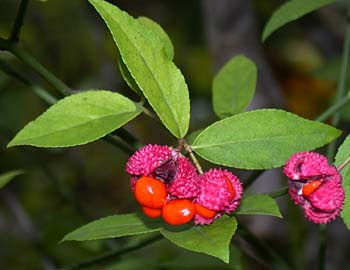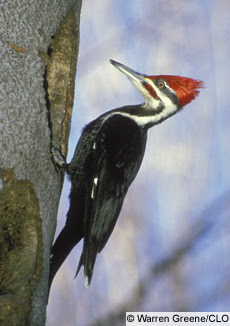Boogie Woogie Aphid
Boogie Woogie Aphid by Dr. James H. BlakeThe Beech Blight Aphid a.k.a. the Boogie Woogie Aphid (Grylloprociphilus imbricator) prefers American beech.
Nymphs of the blight aphid exude white, waxy filaments, and the aphid forms large colonies that first appear
on twigs and branches, then on leaves. The blight aphids wiggle their abdomens in unison when disturbed,
giving rise to the unapproved common name "boogie-woogie aphid." I saw two different trees that had patches of bark covered with these varmints. It looked like the branch was churning in snow!
Strawberry Bush (Euonymus americanus)
The common names, which include American strawberry-bush, hearts-a-bustin', and bursting heart, refer to the odd red fruits that burst open in late fall.Rattlesnake plantain Goodyera pubescens
 We found this terrestrial orchid somewhat near the beginning of the path.
We found this terrestrial orchid somewhat near the beginning of the path.Pileated_Woodpecker
 According to Dan, one of our naturalist helpers, these birds spot humans in their area before any human will ever spot them. Their loud call is an announcement that they know we are in their territory and they don't like it! You won't have to find them, they will find you. Click here to hear their amazing call.Nearly as large as a crow, the Pileated Woodpecker is the largest woodpecker in most of North America. Its loud ringing calls and huge, rectangular excavations in dead trees announce its presence in forests across the continent.
According to Dan, one of our naturalist helpers, these birds spot humans in their area before any human will ever spot them. Their loud call is an announcement that they know we are in their territory and they don't like it! You won't have to find them, they will find you. Click here to hear their amazing call.Nearly as large as a crow, the Pileated Woodpecker is the largest woodpecker in most of North America. Its loud ringing calls and huge, rectangular excavations in dead trees announce its presence in forests across the continent.

Liverworts: Marchantiophyta are a division of bryophyte plants

 You will find these one-celled plants clinging to the rocks near the falls.
You will find these one-celled plants clinging to the rocks near the falls.
Bloodroot: Sanguinaria canadensis

 You will find these one-celled plants clinging to the rocks near the falls.
You will find these one-celled plants clinging to the rocks near the falls. The roots of this plant are red when broken open. Indians used it to dye their baskets red and it was used as a folk remedy to cure cancer. The roots of this plant are highly toxic and if applied to the skin will cause severe protein degeneration. If ingested it will cause death.
The roots of this plant are red when broken open. Indians used it to dye their baskets red and it was used as a folk remedy to cure cancer. The roots of this plant are highly toxic and if applied to the skin will cause severe protein degeneration. If ingested it will cause death.We saw a lot more interesting plants like foam flowers, jack-in-the-pulpits and others. This is a fantastic hike and not too strenuous. I hope to go back in March to hear the sounds of the American toads,Bufo americanus, during their two week mating period.


Hope you can join me!
No comments:
Post a Comment